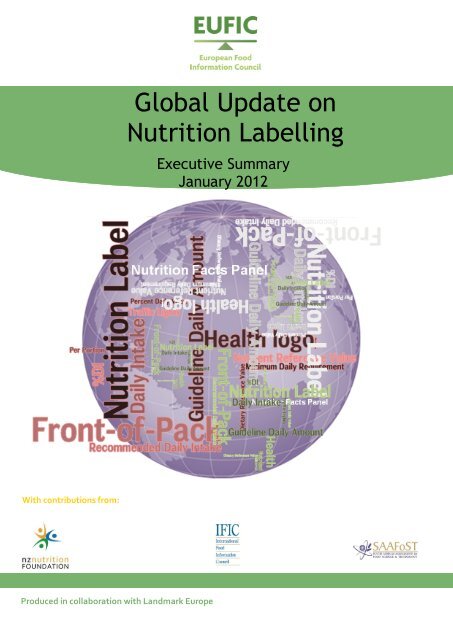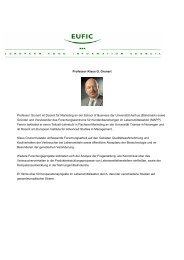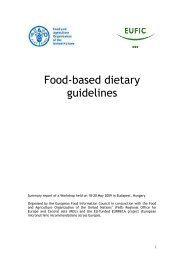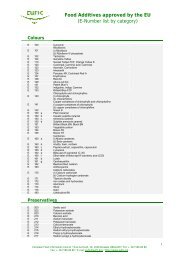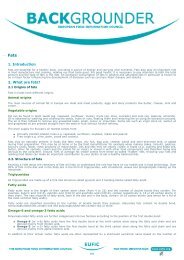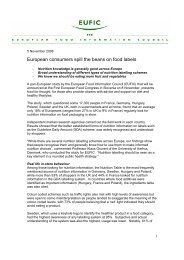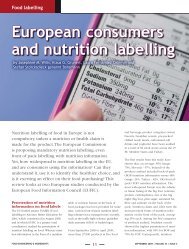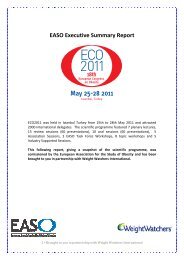Global Update on Nutrition Labelling - The European Food ...
Global Update on Nutrition Labelling - The European Food ...
Global Update on Nutrition Labelling - The European Food ...
You also want an ePaper? Increase the reach of your titles
YUMPU automatically turns print PDFs into web optimized ePapers that Google loves.
EUFIC’s <str<strong>on</strong>g>Global</str<strong>on</strong>g> <str<strong>on</strong>g>Update</str<strong>on</strong>g> <strong>on</strong> Nutriti<strong>on</strong> <strong>Labelling</strong> - January 2012<br />
<str<strong>on</strong>g>Global</str<strong>on</strong>g> <str<strong>on</strong>g>Update</str<strong>on</strong>g> <strong>on</strong><br />
Nutriti<strong>on</strong> <strong>Labelling</strong><br />
Executive Summary<br />
January 2012<br />
With c<strong>on</strong>tributi<strong>on</strong>s from:<br />
Produced in collaborati<strong>on</strong> with Landmark Europe<br />
1
EUFIC’s <str<strong>on</strong>g>Global</str<strong>on</strong>g> <str<strong>on</strong>g>Update</str<strong>on</strong>g> <strong>on</strong> Nutriti<strong>on</strong> <strong>Labelling</strong> - January 2012<br />
2<br />
This page has been intenti<strong>on</strong>ally left blank
EUFIC’s <str<strong>on</strong>g>Global</str<strong>on</strong>g> <str<strong>on</strong>g>Update</str<strong>on</strong>g> <strong>on</strong> Nutriti<strong>on</strong> <strong>Labelling</strong> - January 2012<br />
Acknowledgement<br />
This report has been compiled by the <strong>European</strong> <strong>Food</strong> Informati<strong>on</strong> Council based <strong>on</strong><br />
input from the Internati<strong>on</strong>al <strong>Food</strong> Informati<strong>on</strong> Council, New Zealand Nutriti<strong>on</strong><br />
Foundati<strong>on</strong> and South African Associati<strong>on</strong> of <strong>Food</strong> Science and Technology and past<br />
input from the Asian <strong>Food</strong> Informati<strong>on</strong> Centre and Canadian Council <strong>on</strong> <strong>Food</strong> and<br />
Nutriti<strong>on</strong>.<br />
© <strong>European</strong> <strong>Food</strong> Informati<strong>on</strong> Council 2012<br />
Published by the <strong>European</strong> <strong>Food</strong> Informati<strong>on</strong> Council<br />
Tassel House, Paul-Emile Jans<strong>on</strong> 6, 1000 Brussels, Belgium<br />
www.eufic.org<br />
All rights reserved. No part of this publicati<strong>on</strong> may be reproduced, stored in a<br />
retrieval system, or transmitted in any form or by any means, electr<strong>on</strong>ic,<br />
mechanical, photocopying, recording or otherwise, without prior permissi<strong>on</strong> from the<br />
copyright owners.<br />
3
Executive Summary<br />
EUFIC’s <str<strong>on</strong>g>Global</str<strong>on</strong>g> <str<strong>on</strong>g>Update</str<strong>on</strong>g> <strong>on</strong> Nutriti<strong>on</strong> <strong>Labelling</strong> - January 2012<br />
Nutriti<strong>on</strong> labelling is the provisi<strong>on</strong> of informati<strong>on</strong> about the nutriti<strong>on</strong>al c<strong>on</strong>tent of individual<br />
food products. It is most comm<strong>on</strong>ly applied to pre-packaged food and beverage products,<br />
but comes in a variety of formats. Variables include: the type and number of nutrients<br />
labelled, the reference values used, whether the informati<strong>on</strong> appears <strong>on</strong> fr<strong>on</strong>t-of-pack (FOP)<br />
or back-of-pack (BOP) and whether the label gives any interpretative guidance to the<br />
c<strong>on</strong>sumer.<br />
<strong>The</strong> rise of overweight and obesity has focused policymakers’ attenti<strong>on</strong> <strong>on</strong> the provisi<strong>on</strong> of<br />
nutriti<strong>on</strong> informati<strong>on</strong> as it is hailed as an important instrument in promoting healthier eating<br />
habits. In some countries, government regulati<strong>on</strong>s for nutriti<strong>on</strong> labelling have been in place<br />
for many years; others have <strong>on</strong>ly recently developed a statutory framework for the provisi<strong>on</strong><br />
of nutriti<strong>on</strong> informati<strong>on</strong>. In both circumstances, the provisi<strong>on</strong> of nutriti<strong>on</strong> informati<strong>on</strong> <strong>on</strong> the<br />
FOP is becoming an increasingly prominent policy issue. Meanwhile, voluntary FOP nutriti<strong>on</strong><br />
labelling initiatives proliferate.<br />
A number of reports in recent years have examined how c<strong>on</strong>sumers perceive and use<br />
nutriti<strong>on</strong> labels and assessed c<strong>on</strong>sumer preferences for different nutriti<strong>on</strong> labelling schemes.<br />
This <str<strong>on</strong>g>Global</str<strong>on</strong>g> <str<strong>on</strong>g>Update</str<strong>on</strong>g> seeks to provide a comprehensive overview of the state of play <strong>on</strong> the<br />
issue today: what are the major nutriti<strong>on</strong> labelling initiatives adopted or in the pipeline to<br />
date? How do they work? What do the various stakeholders say? What does the research<br />
show? <strong>The</strong> key objectives are as follows:<br />
To give an up-to-date, comprehensive snapshot of the situati<strong>on</strong> worldwide.<br />
To evaluate research and practical experiences to date, so as to identify examples of best<br />
practice.<br />
To highlight emerging trends and remaining knowledge gaps.<br />
To suggest ways forward, particularly with respect to c<strong>on</strong>sumer research.<br />
Snapshot of <str<strong>on</strong>g>Global</str<strong>on</strong>g> Trends<br />
At the nati<strong>on</strong>al level, countries can be grouped into two broad categories based <strong>on</strong> their<br />
statutory regulati<strong>on</strong>s <strong>on</strong> nutriti<strong>on</strong> labelling:<br />
1. Mandatory: Those which make nutriti<strong>on</strong> labelling mandatory (<strong>European</strong> Uni<strong>on</strong> (EU)<br />
member states, United States, Canada, Mexico, Argentina, Brazil, Chile,<br />
Colombia, Ecuador, Paraguay, Uruguay, Israel, India, Ind<strong>on</strong>esia, China,<br />
H<strong>on</strong>g K<strong>on</strong>g, South Korea, Malaysia, Taiwan, Australia and New Zealand),<br />
even in the absence of a nutriti<strong>on</strong> or health claim. <strong>The</strong>y define which nutrients must<br />
be listed and <strong>on</strong> what basis (e.g. per 100g/per serving). <strong>The</strong>y also allow voluntary<br />
initiatives to provide additi<strong>on</strong>al nutriti<strong>on</strong> informati<strong>on</strong>.<br />
2. Voluntary: Those which provide state-sp<strong>on</strong>sored guidelines to be followed voluntarily<br />
(Gulf Cooperati<strong>on</strong> Council countries, Venezuela, Turkey, Singapore,<br />
Philippines, Thailand, Japan, Kenya, Mauritius, Nigeria and South Africa).<br />
<strong>The</strong>y define which nutrients should be listed and <strong>on</strong> what basis, but labelling is not<br />
mandatory unless a health or nutriti<strong>on</strong> claim is made or unless the food is for special<br />
dietary uses.<br />
4
<str<strong>on</strong>g>Global</str<strong>on</strong>g> overview of mandatory and voluntary nutriti<strong>on</strong> labelling<br />
EUFIC’s <str<strong>on</strong>g>Global</str<strong>on</strong>g> <str<strong>on</strong>g>Update</str<strong>on</strong>g> <strong>on</strong> Nutriti<strong>on</strong> <strong>Labelling</strong> - January 2012<br />
Mandatory nutriti<strong>on</strong><br />
labelling <strong>on</strong> some<br />
or all pre-packaged<br />
foods<br />
Voluntary nutriti<strong>on</strong><br />
labelling unless<br />
health or nutriti<strong>on</strong><br />
claims are made or<br />
foods for special<br />
dietary uses<br />
Informati<strong>on</strong> not<br />
found<br />
Internati<strong>on</strong>al organisati<strong>on</strong>s (e.g. Codex Alimentarius, EU) and some countries provide<br />
guidelines for nutriti<strong>on</strong> labelling. <strong>The</strong> final list of nutrients recommended by Codex includes<br />
energy, protein, available carbohydrates, fat and saturated fat, sodium and sugar (Codex<br />
Alimentarius, 2011a). <strong>The</strong> Associati<strong>on</strong> of Southeast Asian Nati<strong>on</strong>s (ASEAN) does not<br />
currently provide harm<strong>on</strong>ised rules for food products, although it is a stated aim of ASEAN<br />
members (Gauthier, 2010).<br />
Mandatory Nutriti<strong>on</strong> <strong>Labelling</strong> Trend<br />
Many countries that had voluntary guidelines in place have put in place mandatory nutriti<strong>on</strong><br />
labelling. For example, China, which previously had voluntary nutriti<strong>on</strong> labelling, adopted a<br />
nati<strong>on</strong>al standard for mandatory nutriti<strong>on</strong> labelling, which takes effect <strong>on</strong> 1 January 2013. In<br />
additi<strong>on</strong>, the EU, which also had voluntary nutriti<strong>on</strong> labelling previously, adopted a Regulati<strong>on</strong><br />
<strong>on</strong> <strong>Food</strong> Informati<strong>on</strong> to C<strong>on</strong>sumers in September 2011 that makes nutriti<strong>on</strong> labelling<br />
mandatory. According to the new regulati<strong>on</strong>, operators must display the energy value, fat,<br />
saturates, carbohydrates, protein, sugars and salt per 100g or per 100ml. <strong>The</strong> informati<strong>on</strong><br />
may be shown per porti<strong>on</strong> and as percentages of reference intake (i.e. Guideline Daily<br />
Amounts – GDAs) in additi<strong>on</strong>. In order to improve legibility, the new regulati<strong>on</strong> has also<br />
adopted a minimum f<strong>on</strong>t size of 1.2 mm for the x-height for all mandatory informati<strong>on</strong><br />
(<strong>European</strong> Uni<strong>on</strong>, 2011).<br />
<strong>The</strong> inc<strong>on</strong>sistent presence of nutriti<strong>on</strong> labelling <strong>on</strong> food and drink products fuelled the<br />
<strong>European</strong> debate. An EU-funded research project, FLABEL, found that the proporti<strong>on</strong> of<br />
products in 5 product categories carrying BOP nutriti<strong>on</strong> labelling ranges from 70% to around<br />
95% in the EU-27 (FLABEL, 2009). However, in August 2009 the Federati<strong>on</strong> of German<br />
C<strong>on</strong>sumer Organisati<strong>on</strong>s (VZVBZ) examined 3,500 products from about 50 companies and<br />
found that almost half of the products did not display the nutriti<strong>on</strong>al c<strong>on</strong>tent of calories,<br />
protein, sugar, fat, saturated fat, fibre and sodium (Allen, 2009). <strong>The</strong> presence of FOP<br />
nutriti<strong>on</strong> labelling also varies across the EU, and is found <strong>on</strong> average <strong>on</strong> 48% of all products<br />
in the EU and Turkey and up to 82% of all products in the UK (FLABEL, 2009).<br />
5
EUFIC’s <str<strong>on</strong>g>Global</str<strong>on</strong>g> <str<strong>on</strong>g>Update</str<strong>on</strong>g> <strong>on</strong> Nutriti<strong>on</strong> <strong>Labelling</strong> - January 2012<br />
Standardisati<strong>on</strong> of Fr<strong>on</strong>t-of-Pack Labels<br />
Additi<strong>on</strong>ally, FOP nutriti<strong>on</strong> labels are being c<strong>on</strong>sidered by several countries (e.g. Australia,<br />
New Zealand, United States, Canada). Key c<strong>on</strong>siderati<strong>on</strong>s are whether to make FOP<br />
labels mandatory and if so, whether they should emphasise a judgement of nutriti<strong>on</strong>al quality<br />
through colour-coding (e.g. “traffic lights”), a symbolic “health logo” based <strong>on</strong> nutriti<strong>on</strong><br />
criteria that determine whether a product qualifies to bear the health logo within a food or<br />
beverage category (e.g. heart symbol, “Green Keyhole”), or provide informati<strong>on</strong> as a percent<br />
of daily c<strong>on</strong>sumpti<strong>on</strong>, such as guideline daily amounts (GDAs). <strong>The</strong> debate <strong>on</strong> the format of<br />
FOP labels gathered momentum when the UK <strong>Food</strong> Standards Agency (FSA) launched a<br />
“traffic light” scheme for FOP labels. Many c<strong>on</strong>sumer groups, public health NGOs and some<br />
governments in Europe, the United States, and the Asia-Pacific regi<strong>on</strong> have voiced<br />
support for the UK FSA’s traffic light scheme. In May 2011, Thailand became the first<br />
country to introduce mandatory FOP nutriti<strong>on</strong> labels for five snack categories.<br />
While governments have been c<strong>on</strong>sidering FOP labels and revising statutory regulati<strong>on</strong>s,<br />
many variants of the above-menti<strong>on</strong>ed nutriti<strong>on</strong> labelling schemes have proliferated under<br />
the sp<strong>on</strong>sorship of governments, internati<strong>on</strong>al organisati<strong>on</strong>s, NGOs, industry associati<strong>on</strong>s and<br />
individual companies in order to make the nutriti<strong>on</strong>al informati<strong>on</strong> more accessible to<br />
c<strong>on</strong>sumers.<br />
<strong>The</strong> variety of nutriti<strong>on</strong> labelling schemes has led to<br />
calls for a single format for FOP labels based <strong>on</strong><br />
harm<strong>on</strong>ised nutrient criteria. In resp<strong>on</strong>se to pressure<br />
to standardise a single format for FOP labels, the<br />
United States <strong>Food</strong> and Drug Administrati<strong>on</strong> (FDA)<br />
announced their intenti<strong>on</strong> in 2009 to pursue new<br />
regulati<strong>on</strong> in an effort to unify a FOP labelling system<br />
and reduce c<strong>on</strong>sumer c<strong>on</strong>fusi<strong>on</strong> (United States <strong>Food</strong><br />
and Drug Administrati<strong>on</strong>, 2009c). <strong>The</strong> agency has<br />
also drafted a letter to industry to serve as guidance<br />
regarding point-of-purchase food labelling (United<br />
States <strong>Food</strong> and Drug Administrati<strong>on</strong>, 2009d) and,<br />
al<strong>on</strong>g with the Centers for Disease C<strong>on</strong>trol and<br />
Preventi<strong>on</strong> (CDC), commissi<strong>on</strong>ed the Institute of<br />
Medicine (IOM) to review FOP nutriti<strong>on</strong> rating<br />
<strong>The</strong> prevailing view in<br />
countries with mandatory<br />
and voluntary labelling alike<br />
is that standardised labels<br />
are preferable to a multitude<br />
of different nutriti<strong>on</strong> labels.<br />
<strong>The</strong>re remains broad<br />
disagreement, however, <strong>on</strong><br />
what format is most<br />
effective at influencing<br />
c<strong>on</strong>sumer behaviour.<br />
systems and symbols (Institute of Medicine, 2010). In light of this development, some<br />
programs decided to postp<strong>on</strong>e operati<strong>on</strong>s. For example, <strong>on</strong> 23 October 2009 the Smart<br />
Choices Program TM , which was developed by the Keyst<strong>on</strong>e Center <strong>Food</strong> and Nutriti<strong>on</strong><br />
Roundtable, voluntarily postp<strong>on</strong>ed active operati<strong>on</strong>s.<br />
In October 2010, the IOM Committee <strong>on</strong> Examinati<strong>on</strong> of FOP Nutriti<strong>on</strong> Rating Systems and<br />
Symbols released their Phase I Report. After reviewing 20 FOP labelling systems, the IOM<br />
Committee recommended a nutrient-specific system that highlights four nutrients of greatest<br />
c<strong>on</strong>cern: calories, serving size, trans fat, saturated fat and sodium. <strong>The</strong> IOM Committee<br />
released their Phase II Report <strong>on</strong> c<strong>on</strong>sumer receptivity, understanding and usability of specific<br />
FOP labelling systems <strong>on</strong> 20 October 2011. <strong>The</strong> IOM Committee made two recommendati<strong>on</strong>s:<br />
• <strong>The</strong> U.S. FDA and USDA should develop, test, and implement a single, standard FOP<br />
system to appear <strong>on</strong> all products; and<br />
• Implementati<strong>on</strong> should include a multi-stakeholder, multi-faceted awareness and<br />
promoti<strong>on</strong> campaign that includes <strong>on</strong>going m<strong>on</strong>itoring, research, and evaluati<strong>on</strong><br />
<strong>The</strong> rating system recommended by the IOM Committee incorporates symbols to display <strong>on</strong><br />
6
EUFIC’s <str<strong>on</strong>g>Global</str<strong>on</strong>g> <str<strong>on</strong>g>Update</str<strong>on</strong>g> <strong>on</strong> Nutriti<strong>on</strong> <strong>Labelling</strong> - January 2012<br />
the FOP that graphically c<strong>on</strong>vey calorie counts by serving size and a “point” value showing<br />
whether the saturated and trans fat, sodium and added sugars in the products are below<br />
threshold levels (Institute of Medicine, 2011). This system has not yet been c<strong>on</strong>sumer tested.<br />
In the meantime, the Grocery Manufacturers of American (GMA) and the <strong>Food</strong> Marketing<br />
Institute (FMI), representing leading U.S. food and beverage manufacturers and retailers<br />
respectively, launched a new voluntary fact-based FOP nutriti<strong>on</strong> labelling system called<br />
Nutriti<strong>on</strong> Keys. This system adds nutriti<strong>on</strong> informati<strong>on</strong> <strong>on</strong> calories and other important<br />
nutrients (saturated fat, sodium and total sugars c<strong>on</strong>tent) to the FOP of many of the country’s<br />
food and beverage products. Operators may choose to display up to two out of eight of the<br />
“nutrients to encourage” (e.g. fibre, calcium) <strong>on</strong> the FOP in additi<strong>on</strong>. <strong>The</strong> Nutriti<strong>on</strong> Keys<br />
labelling c<strong>on</strong>cept was c<strong>on</strong>sumer tested to determine comprehensi<strong>on</strong>, ease of understanding<br />
and interpretati<strong>on</strong>. <strong>The</strong> labels will be rolled out in the coming<br />
m<strong>on</strong>ths according to seas<strong>on</strong>ality and producti<strong>on</strong> schedules and<br />
promoted with a $50 milli<strong>on</strong> c<strong>on</strong>sumer educati<strong>on</strong> campaign in<br />
autumn 2011.<br />
<strong>The</strong> directi<strong>on</strong> the<br />
U.S. and EU take will<br />
certainly have global<br />
implicati<strong>on</strong>s.<br />
Another key recent development for FOP labels is the EU’s<br />
adopti<strong>on</strong> of the Regulati<strong>on</strong> <strong>on</strong> <strong>Food</strong> Informati<strong>on</strong> to C<strong>on</strong>sumers.<br />
<strong>The</strong> regulati<strong>on</strong> allows for voluntary FOP labelling, but if operators choose to display FOP<br />
nutriti<strong>on</strong> informati<strong>on</strong>, it must follow the regulati<strong>on</strong>. <strong>The</strong> informati<strong>on</strong> for energy, fat, saturates,<br />
sugars and salt may be repeated <strong>on</strong> the FOP per 100g/ml or per porti<strong>on</strong>. Additi<strong>on</strong>al forms of<br />
expressi<strong>on</strong> and presentati<strong>on</strong> of the nutriti<strong>on</strong> declarati<strong>on</strong>, such as colours, graphical forms or<br />
symbols, are permitted under certain c<strong>on</strong>diti<strong>on</strong>s established in the regulati<strong>on</strong>.<br />
In Australia and New Zealand, the nutriti<strong>on</strong> labelling debate has reached a critical stage as<br />
the <strong>Food</strong> <strong>Labelling</strong> Law and Policy review for the Ministerial Council of <strong>Food</strong> Standards<br />
Australia New Zealand (FSANZ) was released in January 2011. <strong>The</strong> review recommends that a<br />
voluntary multiple traffic lights FOP labelling system should be introduced and should be<br />
mandatory if health claims are made or equivalent endorsements, trade names or marks<br />
appear <strong>on</strong> the label (Blewett et al., 2011). <strong>The</strong> Ministerial Council did not immediately<br />
endorse the report’s recommendati<strong>on</strong> for a traffic light system at its meeting in December<br />
2011 and has opted for further c<strong>on</strong>sultati<strong>on</strong> instead. Officials shall provide a substantial<br />
report <strong>on</strong> the development of a FoP labelling scheme within six m<strong>on</strong>ths, with a view to<br />
agreeing <strong>on</strong> a system by end 2012.<br />
In Asia, South Korea was the first country to press ahead with recommendati<strong>on</strong>s for<br />
voluntary traffic light labels <strong>on</strong> children’s food starting 1 January 2011. <strong>The</strong> Korean <strong>Food</strong> and<br />
Drug Administrati<strong>on</strong> revealed a draft plan for its system in May 2010, which would attach a<br />
red, yellow or green label to the package of food items depending <strong>on</strong> the amounts of fat,<br />
saturated fat, sugars and sodium. This move could potentially have implicati<strong>on</strong>s for other<br />
countries in the Asia-Pacific regi<strong>on</strong>.<br />
<strong>The</strong> Way Forward<br />
<strong>The</strong> debate over which nutriti<strong>on</strong> labelling scheme is the most effective will certainly c<strong>on</strong>tinue<br />
in Europe, Asia-Pacific and the United States for the foreseeable future. More research<br />
would certainly be useful to inform these discussi<strong>on</strong>s. Governments, NGOs, food<br />
manufacturers and retailers have all explored which scheme c<strong>on</strong>sumers might prefer, for<br />
what reas<strong>on</strong>s and how certain schemes impact purchasing behaviour and balanced choices.<br />
While some evidence has emerged <strong>on</strong> several of these issues, there remains no c<strong>on</strong>sensus<br />
am<strong>on</strong>g stakeholders <strong>on</strong> the way forward. Evidence <strong>on</strong> the impact of the various schemes <strong>on</strong><br />
purchasing behaviour, and therefore <strong>on</strong> their relative effectiveness in helping c<strong>on</strong>sumers<br />
make balanced choices, also remains limited, partly because of the relative novelty of<br />
7
interpretative guidance schemes in the market<br />
place.<br />
N<strong>on</strong>etheless, there is agreement <strong>on</strong> the need to<br />
provide c<strong>on</strong>sumers with more informative and<br />
simpler nutriti<strong>on</strong> informati<strong>on</strong> <strong>on</strong> food labels. <strong>The</strong><br />
mandatory Nutriti<strong>on</strong> Facts Panel/Table is<br />
regarded as a public health tool that is intended<br />
to assist c<strong>on</strong>sumers in making informed and<br />
healthful food choices in the EU, the United<br />
States, Canada, H<strong>on</strong>g K<strong>on</strong>g, Malaysia,<br />
Australia, New Zealand and India. Yet, like<br />
EUFIC’s <str<strong>on</strong>g>Global</str<strong>on</strong>g> <str<strong>on</strong>g>Update</str<strong>on</strong>g> <strong>on</strong> Nutriti<strong>on</strong> <strong>Labelling</strong> - January 2012<br />
<strong>The</strong> debate over which nutriti<strong>on</strong><br />
labelling scheme is the most<br />
effective will certainly c<strong>on</strong>tinue<br />
in Europe, Asia-Pacific and the<br />
United States for the foreseeable<br />
future. More research would<br />
certainly be useful to inform<br />
these discussi<strong>on</strong>s.<br />
all tools, it <strong>on</strong>ly has an impact if it is suited to its task and if c<strong>on</strong>sumers actually understand<br />
and use it. <strong>The</strong>re is a growing opini<strong>on</strong> in the United States that the Nutriti<strong>on</strong> Facts Panel is<br />
not enough or that it should be revised to make it more understandable and usable.. While<br />
the dietary guideline approach (e.g. GDAs, % daily intake) for BOP labels has gathered much<br />
support am<strong>on</strong>g food manufacturers and policy-makers, its usefulness to guide c<strong>on</strong>sumer<br />
choices will depend to a significant extent <strong>on</strong> the effort that is made in educating c<strong>on</strong>sumers<br />
about how to use it.<br />
Also, by providing nutriti<strong>on</strong> informati<strong>on</strong> about the nutrient c<strong>on</strong>tent of foods, nutriti<strong>on</strong> labelling<br />
allows for—but does not necessarily cause—more healthful food choices. Corollary issues to<br />
c<strong>on</strong>sider include the questi<strong>on</strong> of what factors underlie c<strong>on</strong>sumer motivati<strong>on</strong> to make changes<br />
in their diets and how appropriate and meaningful nutriti<strong>on</strong> informati<strong>on</strong> can be provided <strong>on</strong><br />
the food label so that motivated c<strong>on</strong>sumers can act <strong>on</strong> their desire to improve their diets.<br />
SUMMARY POINTS<br />
Policy decisi<strong>on</strong>s should fundamentally be based <strong>on</strong> science: the key<br />
questi<strong>on</strong> is which labelling scheme gives the best guidance from a<br />
nutriti<strong>on</strong>al point of view. In this respect, it is clear that what matters is the<br />
overall diet, not the c<strong>on</strong>sumpti<strong>on</strong> of an individual product.<br />
Nutriti<strong>on</strong> labelling policy should take into account c<strong>on</strong>sumer use,<br />
interpretati<strong>on</strong> and understanding of different nutriti<strong>on</strong> labelling<br />
schemes, but ultimately it is the impact <strong>on</strong> purchasing decisi<strong>on</strong>s<br />
and overall diets that matters. <strong>The</strong> c<strong>on</strong>sumer research secti<strong>on</strong> of this report<br />
shows that these factors vary from country to country and am<strong>on</strong>g c<strong>on</strong>sumer segments.<br />
Most research <strong>on</strong> FOP formats has been c<strong>on</strong>ducted in Europe and North America. Given<br />
the potential for variance, studies in other regi<strong>on</strong>s are needed to understand better local<br />
c<strong>on</strong>sumer attitudes, especially in South Africa, which may adopt a uniquely South<br />
African scheme. Publicly available research <strong>on</strong> the actual impact of FOP nutriti<strong>on</strong> labels is<br />
limited, particularly in the United States. Programs like NuVal, Hannaford Guiding Stars,<br />
Smart Choices and Nutriti<strong>on</strong> Keys/Facts Up Fr<strong>on</strong>t have completed c<strong>on</strong>sumer research<br />
regarding c<strong>on</strong>sumers’ preference for logos and intended use, but the overall impact is not<br />
publicly known as sales data are often proprietary.<br />
8
EUFIC’s <str<strong>on</strong>g>Global</str<strong>on</strong>g> <str<strong>on</strong>g>Update</str<strong>on</strong>g> <strong>on</strong> Nutriti<strong>on</strong> <strong>Labelling</strong> - January 2012<br />
Further c<strong>on</strong>sumer research seems to be needed in particular <strong>on</strong> the<br />
following questi<strong>on</strong>s:<br />
Do c<strong>on</strong>sumers make l<strong>on</strong>g-term healthier food choices as a<br />
result of having used nutriti<strong>on</strong> informati<strong>on</strong> <strong>on</strong> food<br />
packaging? Some research has shown that c<strong>on</strong>sumers understand and know<br />
how to use accurately various nutriti<strong>on</strong> labels should they choose to do so, and<br />
studies in Europe have shown no dem<strong>on</strong>strable short-term effect <strong>on</strong> purchasing<br />
decisi<strong>on</strong>s. Little is known about whether c<strong>on</strong>sumers make l<strong>on</strong>g-term healthier<br />
food choices as a result of having used nutriti<strong>on</strong> informati<strong>on</strong>. If healthier food<br />
choices cannot be traced to nutriti<strong>on</strong> informati<strong>on</strong>, other factors that motivate<br />
healthier food choices should be identified.<br />
To what extent do nutriti<strong>on</strong> labelling schemes have to be<br />
standardised to help c<strong>on</strong>sumers cultivate healthy eating<br />
habits? Research by FLABEL and EUFIC in Europe and by the Australian Heart<br />
Foundati<strong>on</strong> in Australia suggests that different labelling schemes can be equally<br />
effective in helping c<strong>on</strong>sumers identify healthy opti<strong>on</strong>s, yet many groups<br />
discussed in this report assert that standardised nutriti<strong>on</strong> labels are imperative. A<br />
future study <strong>on</strong> the impact of the EU regulati<strong>on</strong> and c<strong>on</strong>sumer testing of the<br />
United States FDA’s plans to standardise the nutriti<strong>on</strong>al criteria <strong>on</strong> which FOP<br />
nutriti<strong>on</strong> labelling must be based would be insightful.<br />
How can c<strong>on</strong>sumers best be helped to make good use of<br />
nutriti<strong>on</strong> labels to make better food choices? Research suggests<br />
that good use of nutriti<strong>on</strong> labels is related to better nutriti<strong>on</strong> knowledge, and that<br />
overall use is linked to health motivati<strong>on</strong>. How can c<strong>on</strong>sumers be motivated to<br />
eat more healthily? What awareness raising and educati<strong>on</strong> initiatives are most<br />
effective? Who should be the primary target of which informati<strong>on</strong> and educati<strong>on</strong><br />
initiatives – parents, children, others?<br />
Is nutriti<strong>on</strong> labelling bey<strong>on</strong>d packaged foods useful? <strong>The</strong> menu<br />
labelling debate in the United States is amplifying calls for menu labelling in<br />
Canada and the UK. Further research is needed to fully gauge whether nutriti<strong>on</strong><br />
labelling bey<strong>on</strong>d packaged foods has an impact <strong>on</strong> food choices.<br />
9
EUFIC’s <str<strong>on</strong>g>Global</str<strong>on</strong>g> <str<strong>on</strong>g>Update</str<strong>on</strong>g> <strong>on</strong> Nutriti<strong>on</strong> <strong>Labelling</strong> - January 2012<br />
10


